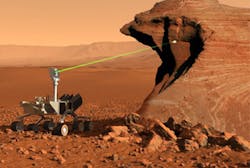Los Alamos, NM--On the successful November 26 NASA launch of the Mars Science Laboratory, the car-sized Curiosity rover was equipped with a remote-detection instrument originally developed at Los Alamos National Laboratory (LANL) called ChemCam that will use blasts of laser energy to remotely probe Mars’s surface, determining whether Mars is or was habitable. The LANL researchers and scientists from the French space institute IRAP will analyze data from a telescope that views the flash of glowing plasma created by vaporized material from the laser and record the colors of light contained within it for spectroscopic analysis. The Curiosity rover is expected to land on Mars in August 2012 after traveling nearly 354 million miles and roam the surface of Mars for about 98 weeks, the period of one Martian year.
"ChemCam is designed to look for lighter elements such as carbon, nitrogen, and oxygen, all of which are crucial for life," said Roger Wiens, principal investigator of the MSL mission’s ChemCam team. "The system can provide immediate, unambiguous detection of water from frost or other sources on the surface as well as carbon—a basic building block of life as well as a possible byproduct of life. This makes the ChemCam a vital component of Curiosity’s mission."
The system looks at the entire visible spectrum as well as portions on either side (the infrared and ultraviolet), which gives ChemCam the ability to see any element on the periodic table. ChemCam can zap an area about 23 feet away from the rover vehicle. The system relies on a technology primarily developed at LANL called laser-induced breakdown spectroscopy (LIBS). At the heart of the technology is an infrared laser that focuses more than a million watts of power onto a tiny area for five-billionths of a second. LIBS has successfully been used on Earth to determine the composition of objects within extreme environments such as inside nuclear reactors and on the sea floor. Other applications for LIBS include cancer detection and environmental monitoring. The Mars Science Laboratory is the technology’s first extraterrestrial use.
The French national space agency, Centre National d’Études Spatiales, and France provided ChemCam’s laser and telescope. LANL supplied ChemCam’s spectrometers and data processors, and leads the overall investigation. Once the rover lands on Mars, LANL operations specialists will control the instrument.
SOURCE: LANL; www.lanl.gov/news/releases/los_alamos_instrument_to_shine_light_on_mars_habitability.html
About the Author

Gail Overton
Senior Editor (2004-2020)
Gail has more than 30 years of engineering, marketing, product management, and editorial experience in the photonics and optical communications industry. Before joining the staff at Laser Focus World in 2004, she held many product management and product marketing roles in the fiber-optics industry, most notably at Hughes (El Segundo, CA), GTE Labs (Waltham, MA), Corning (Corning, NY), Photon Kinetics (Beaverton, OR), and Newport Corporation (Irvine, CA). During her marketing career, Gail published articles in WDM Solutions and Sensors magazine and traveled internationally to conduct product and sales training. Gail received her BS degree in physics, with an emphasis in optics, from San Diego State University in San Diego, CA in May 1986.
